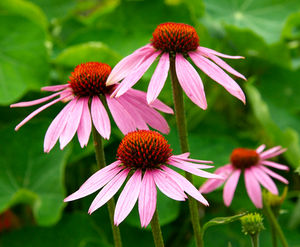Echinacea angustifolia
| See Also | Botanical Monographs |
|---|
Echinacea (Echinacea angustifolia) is widely used in the treatment of both acute and chronic viral and bacterial infections. To explore the characteristics, medicinal uses and prescribing considerations of this herb in more detail, check out the references indicated.[1] [2]
Contents
Characteristics
| Article | Echinacea, NDNR; 2013 February |
|---|
- Common Names: Purple cone flower, Black Sampson, Kansas snakeroot, Red sunflower, Comb flower, Cock up hat, Missouri snakeroot, Indian head
- Family: Compositae/Asteraceae
- Habitat: Echinacea is native to North America and is now cultivate in Europe. The species is considered "at risk".
- Parts Used: Root and rhizome, whole plant
- Constituents: Polysaccharides, glycoproteins, alkamides, caffeic acid derivatives (echinacoside)
- Medicinal Actions: immunostimulant, anti-inflammatory, antimicrobial, antibacterial, antiviral, antiprotozoal, antiparasitic, tonic, vulnerary, antitumour, alterative, antimalarial, decongestant, lymphatic
Uses
Historical Uses:
Echinacea was used as an antidote for blood poisoning, snake bites, syphilis, malaria, typhoid fever, scarlet fever, abscesses, ulcers, insect bites, infections, wounds, burns, toothache, and cancer.
Medicinal Uses:
Internal
- active infections, first sign of infection, chronic viral and bacterial infections, mild septicemia, recurrent candidiasis, recovery from chemotherapy
- Prophylaxis immunostimulation for colds, influenza, and upper respiratory tract infections
- Skin abrasions and ulcerations including boils, sores, cuts, oral cavity inflammation
Topical
Prescribing Considerations
Long term use of greater than 8 weeks is not advised, though some studies show long-term use has no adverse effects. The information provided is intended to augment the treatment from a naturopathic doctor or other trained medical professional. Although most herbs are generally safe, it is recommended that you avoid self-prescribing especially when there is an underlying ongoing medical condition, if you are on any prescription medications or if you are pregnant or breastfeeding.
Formulations and Preparation
Safety
The safety and prescribing considerations for this herb include:[3] [4]
- Generally regarded as safe.
- Side-effects are rare but may include allergic reactions manifesting as asthma attacks, anaphylaxis or urticaria.
- Cautions and Contraindications: systemic diseases (such as tuberculosis, multiple sclerosis, leukosis, collagenosis), auto-immune conditions (such as diabetes mellitus, lupus, rheumatoid arthritis), and HIV infection/AIDS
- Drug-Herb Interactions.[3]
- Cyclosporine and Related Immunosuppressants - Potential or theoretical adverse interaction of uncertain severity; Theoretically, long-term concomitant use might require increased levels of immunosuppression in allograph patients. Inadvertent use without professional care may cause drug failure. Avoid, except for short-term co-administration with professional management.
- Cyclophosphamide - Interaction likely but uncertain occurrence and unclear implications, bimodal or variable interaction with profession management; Immunotherapeutic outcomes of low-dose drug protocols (not cytotoxic schedules) may be enhanced by concomitant administration. High-dose drug effects on myelosuppression may be reduced.
- Interferon Alpha (IFN-alpha), Interleukin-2, and Other Immunotherapeutic Biological Response Modifiers - Interaction likely but uncertain occurrence and unclear, potential or theoretical beneficial or supportive interaction with professional management; Possible additive effect of herb and drug allow sparing of drug, reduction of drug side effects, and enhanced therapeutic responses.
- Myelosuppressive Antineoplastic Chemotherapy (Alkylating Agents, Cytotoxic antibiotics, Antimetabolites, Mitotic inhibitors) - Potential or theoretical beneficial or supportive interaction with professional management; Echinacea may help protect white blood cell counts in chemotherapy-induced myelosuppression. Natural killer cell number and activity increased by long-term administration.
- Tumor Necrosis Factor-Alpha (TNF-alpha) Antagonists - Interaction likely but uncertain occurrence and unclear, bimodal or variable interaction with professional management; Echinacea may theoretically be used to enhance cellular immunity during temporary drug withdrawal mandated by opportunistic infection.
References
- ↑ Boon Heather, Smith Michael 2009 55 Most Common Medicinal Herbs: The Complete Natural Medicine GuideSecond Edition Institute of Naturopathic Education and Research, CCNM Toronto.
- ↑ Godfrey Anthony, Saunders Paul, Barlow Kerry, Gowan Matt. 2011 Principles and Practices of Naturopathic Botanical Medicine, Advanced Botanical Medicine. V3 CCNM Press, Toronto
- ↑ 3.0 3.1 Stargrove Mitchell Bebell, Treasure Jonathan, McKee Dwight L (2008) Herb, Nutrient and Drug Interactions: Clinical Implications and Therapeutic Strategies.
- ↑ Brinker Francis (1997) Herbal Contraindications and Drug Interactions: Plus Herbal Adjuncts With Medicines, 4th Edition Eclectic Medical Publications.
